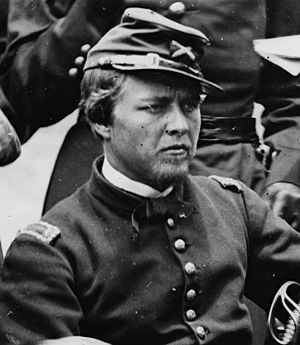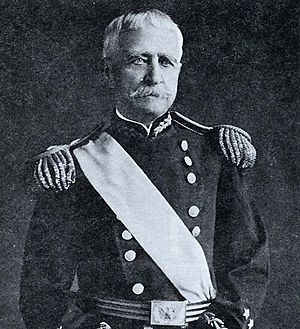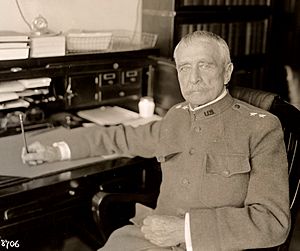Peter Conover Hains facts for kids
Quick facts for kids
Peter Conover Hains
|
|
|---|---|

First Lieutenant Peter C. Hains, 1862. Photo by James F. Gibson. Library of Congress.
|
|
| Born | July 6, 1840 Philadelphia, Pennsylvania, US |
| Died | November 7, 1921 (aged 81) Washington, D.C., US |
| Buried | |
| Allegiance | Union |
| Service/ |
Union Army |
| Years of service | 1861–1904, 1917–1919 |
| Rank | |
| Unit | Corps of Engineers |
| Battles/wars | |
| Relations | John Powers Hains (son) Peter Hains (son) Thornton Jenkins Hains (son) MG Peter C. Hains III (grandson) |
| Signature | |
Peter Conover Hains (born July 6, 1840 – died November 7, 1921) was an important major general in the United States Army. He was a soldier in three major wars: the American Civil War, the Spanish–American War, and World War I. General Hains was also a talented engineer. He helped create the Tidal Basin in Washington, D.C., and played a part in planning the famous Panama Canal.
Contents
Becoming a Soldier and Engineer
Peter Hains was born in Philadelphia, Pennsylvania. He went to the United States Military Academy at West Point, which is a famous school for training army officers. He graduated in June 1861. Some of his classmates at West Point became well-known figures, like George Armstrong Custer.
Serving in the Civil War
Right after graduating, Hains became a second lieutenant and then a first lieutenant in the army. He first commanded an artillery unit, which uses cannons. Later, he joined the Corps of Topographical Engineers, a group of soldiers who made maps and planned military movements.
Hains showed great skill during the war. He earned a special promotion to captain for his actions at the Battle of Hanover Court House. He then joined the main Corps of Engineers.
During the Siege of Vicksburg, a very important battle, Hains was recognized for his excellent work. He helped lead the engineering efforts for the XIII Corps. When Vicksburg was captured in July 1863, he was promoted to major. He continued to serve throughout the war and was later promoted to lieutenant colonel for his service.
Building a Nation: Post-War Engineering
After the Civil War, Hains stayed in the army. He became a major in 1870. A lot of his important work after the war involved designing lighthouses for the U.S. Lighthouse Board. He designed the lighthouses at Morris Island and St. Augustine. He was the chief engineer for building the Morris Island Lighthouse in South Carolina from 1872 to 1876.
Hains continued to rise in rank, becoming a lieutenant colonel in 1886 and a colonel in 1895. One of his most famous projects was designing the Tidal Basin in Washington, D.C. This project helped solve drainage problems and bad smells from the marshlands in the area. A part of East Potomac Park is even named Hains Point in his honor.
During the Spanish–American War, Hains served as a brigadier general. He also played a key role in choosing the location for the Panama Canal. He argued for the site that was eventually chosen, instead of one in Nicaragua. He retired from active duty in 1904 when he reached the age of 64.
Later Years and World War I Service
General Hains faced some personal challenges in his later life, supporting his sons during a difficult time. Despite this, his long and important career was recognized. In 1916, he was promoted to major general on the retired list.
Even though he was retired, General Hains was called back to active duty during World War I in September 1917. He was 77 years old! He served as the chief engineer for the Norfolk Harbor and River District. Then he became the chief engineer for the Eastern Division of the Corps of Engineers. He left active duty in the fall of 1918.
Peter Hains was one of the oldest officers to serve on active duty in U.S. Army history. He was also likely the only person to serve in both the American Civil War and World War I.
General Hains passed away on November 7, 1921, at Walter Reed Army Medical Center. He was buried in Arlington National Cemetery, a special place where many American heroes are laid to rest.
A Military Family Legacy
General Hains came from a family with a strong military tradition. His sons, John Power Hains and Peter Hains Jr., both became army officers. His grandson, Peter C. Hains, III, also became a major general in the U.S. Army. Many members of his family, including his great-grandson and great-great-grandsons, continued to serve as officers in the Army. They are all buried at Arlington National Cemetery.



